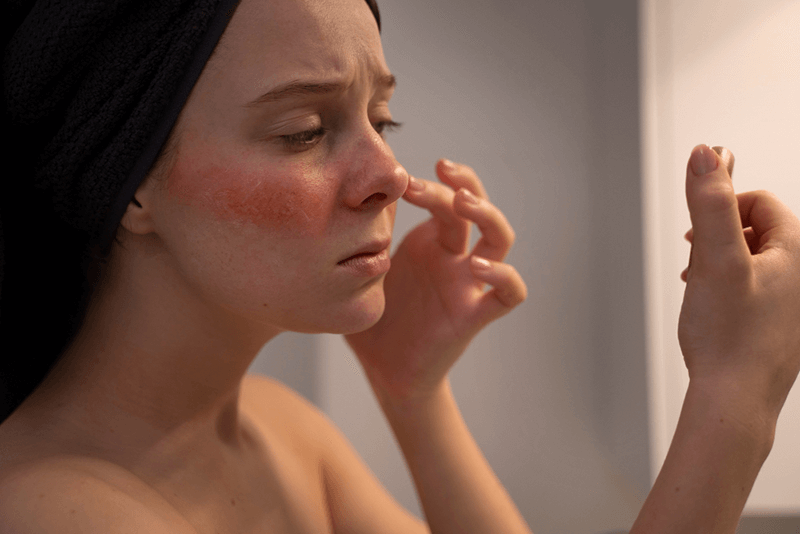Rosacea is a common inflammatory skin condition that causes redness and visible blood vessels in your face. The redness can slowly spread beyond the nose and cheeks to the forehead and chin. Often mistaken for acne, eczema, or a skin allergy, this condition may also produce small, red, pus-filled bumps. There are several signs and symptoms associated with the condition which may flare up for a period of weeks to months and then diminish for a while. Common signs and symptoms include – facial redness, swollen red bumps, visible broken blood vessels, large pores and excess facial skin around the nose. The exact causes of this condition are unknown but a number of factors can trigger symptoms. If left untreated, redness and swelling associated with this condition can get worse and might become permanent leading to severe complications. As there are several rules related to reporting this inflammatory skin condition, dermatology medical billing and coding can be complex. Dermatologists and other physicians treating this condition need to be familiar with the specific ICD-10 codes and outsourcing medical coding to an experienced service provider is a reliable strategy to ensure this.
Reports suggest that rosacea affects about 16 million people in the United States. It is estimated that 1 in 20 people is affected by this chronic skin condition. The disease most commonly affects middle-aged women in the age group of 30 – 60 years, who have fair skin. However, when it occurs in men, the condition tends to be severe and may eventually cause the nose to become enlarged (rhinophyma). Fair-skinned individuals and people who blush easily seem to be more susceptible to this condition.
Types of Rosacea
There are four different subtypes of rosacea namely –
- Subtype one, known as erythematotelangiectatic rosacea (ETR) – symptoms include – facial redness, flushing, and visible blood vessels.
- Subtype two, papulopustular (or acne) rosacea – often affects middle-aged women and involves acne-like breakouts.
- Subtype three, known as rhinophyma – a rare form which usually affects men and causes thickening of the skin on the nose.
- Subtype four, known as ocular rosacea – symptoms are centered on the eye area
Each of these above subtypes involves different symptoms that vary from one person to another.
How Is Rosacea Diagnosed and Treated?
As there is no specific test for diagnosing this skin condition, physicians may begin their initial evaluation by conducting a detailed study about the patient’s medical history, check their symptoms and perform a physical examination of their skin. In some cases, physicians may conduct certain tests to rule out other conditions, such as other forms of acne, psoriasis, eczema or lupus.
Treatment modalities may involve a combination of prescribed medications (applied to the skin) and oral drugs (pills, tablets, or capsules) for controlling the symptoms. These include topical antibiotics (like metronidazole, tretinoin, benzoyl peroxide, and azelaic acid), oral antibiotics (like tetracycline, minocycline, and erythromycin), and steroid eye drops like blephamide and tetracyclines. The duration of your treatment depends on the type and severity of your symptoms. However, recurrence of the symptoms is very common. Laser therapy may help reduce the redness of enlarged blood vessels.
Dermatologists and other specialists providing treatment (that involves diagnosis, screening and other tests) for rosacea patients need to be adequately reimbursed for their services. The diagnosis must be carefully documented using the appropriate medical codes. Medical billing and coding services offered by experienced providers can help physicians use the correct codes for their medical billing purposes.
ICD-10 Codes for Rosacea
- L71 – Rosacea
- L71.0 – Perioral dermatitis
- L71.1 – Rhinophyma
- L71.8 – Other rosacea
- L71.9 – Rosacea, unspecified
Practicing or incorporating certain lifestyle changes and home remedies may help reduce the signs and symptoms of rosacea or prevent flare-ups. Protecting your skin (by wearing hats and avoiding midday sun) and treating your skin gently (by using moisturizer) can help prevent flare-up and occurrence of symptoms to a great extent.
Medical coding for inflammatory skin conditions can be complex. By outsourcing these tasks to a reliable and established medical billing and coding company (that provides the services of AAPC-certified coding specialists), healthcare practices can ensure correct and timely medical billing and claims submission.




